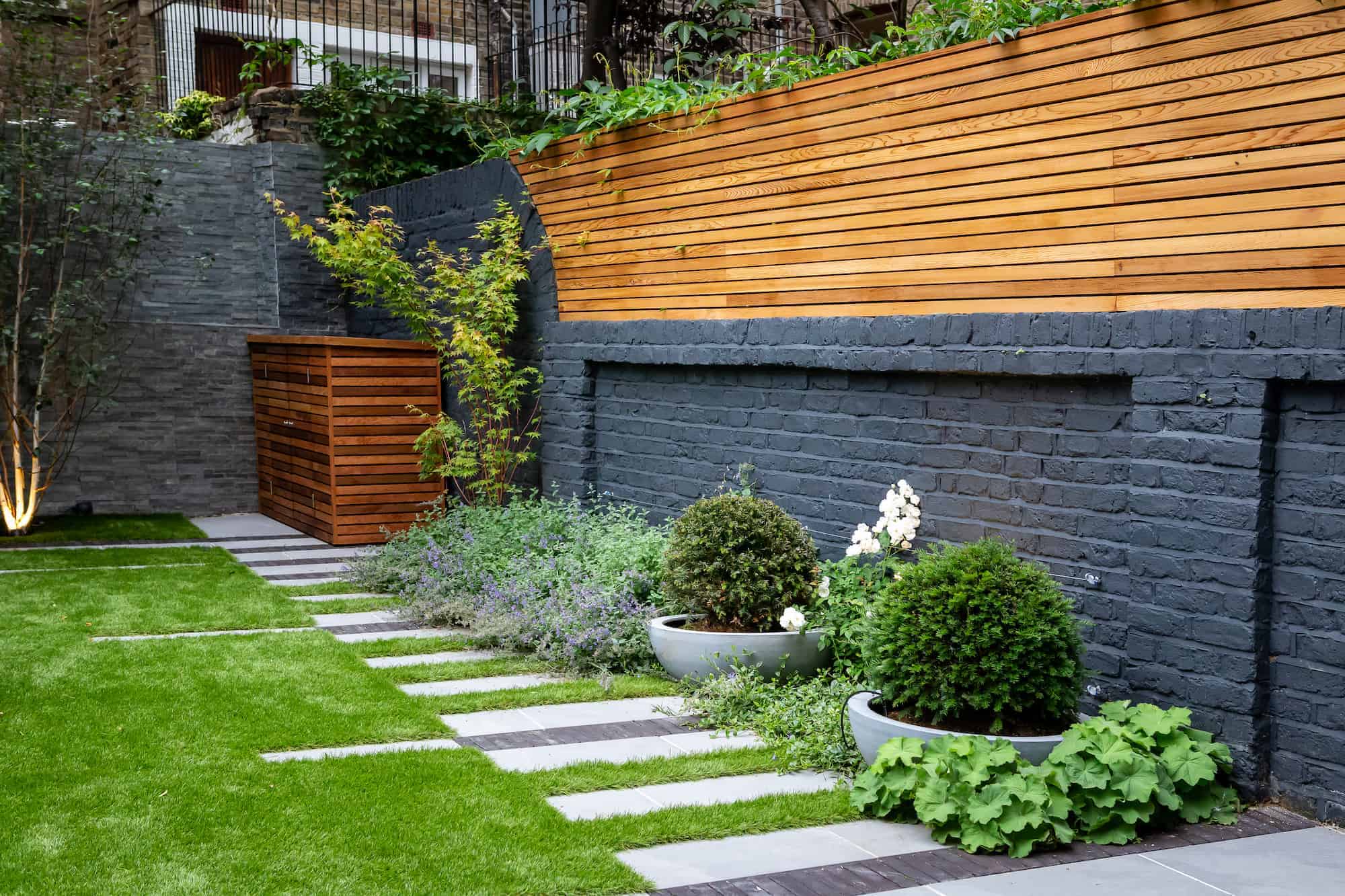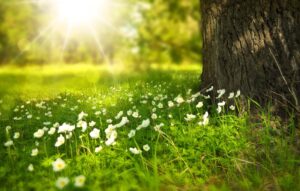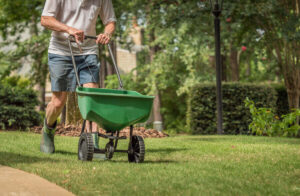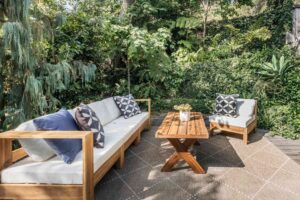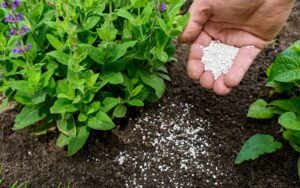Transform Your Outdoor Space: Creative Fence Garden Ideas That Blend Beauty With Function
Your garden fence does far more than mark property lines—it can become the backbone of your landscape design, a vertical growing space, and an expression of your personal style. Whether you’re looking to maximize a small yard, create visual interest, or solve common landscape challenges, thoughtfully designed fence gardens offer solutions that enhance your outdoor living experience.
Reimagining the Humble Garden Boundary
The best fence gardens don’t just separate spaces—they unify your landscape design while solving practical problems. “Fences have evolved from simple barriers to integral design elements,” explains landscape architect Elena Moreno. “Today’s homeowners want their fences to multitask: providing privacy, supporting plants, and creating ambiance.”
Before diving into specific ideas, consider your fence’s primary functions and how enhancing it with plantings can address multiple needs:
- Privacy enhancement without the “fortress effect” of bare fencing
- Vertical growing space for edibles or ornamentals in small gardens
- Microclimate creation by blocking wind or providing shade
- Habitat development for beneficial wildlife and pollinators
- Visual extension of your available gardening space
With these functions in mind, let’s explore creative approaches that won’t break the bank, add distinctive character, and transform ordinary boundaries into extraordinary garden features.
Inexpensive Garden Fence Ideas That Look Anything But Cheap
Creating an impressive fence garden doesn’t require a landscape designer’s budget. These affordable approaches deliver maximum impact while minimizing costs.
Repurposed Material Magic
One of the most budget-friendly approaches to garden fencing involves repurposing existing materials. Consider these tested options:
Pallet Transformation Those free wooden pallets from local businesses can become charming rustic fences with minimal processing. Master gardener Thomas Wilkins recommends: “Select heat-treated (HT) pallets rather than chemically treated ones, especially if you’ll be growing edibles nearby. A light sanding, some weather-resistant stain, and you’ve got a perfectly serviceable fence.”
The vertical slats create natural planting pockets for shallow-rooted specimens like succulents, herbs, and annual flowers. Install small containers or attach pocket planters for an instant vertical garden.
Bamboo Budget Solution Bamboo stakes bundled together create an eco-friendly, inexpensive fence with a distinctive natural appearance. Available in rolls from garden centers at a fraction of the cost of traditional fencing, bamboo offers surprising durability when properly installed.
Landscape designer Mei Lin notes, “The key to longevity with bamboo fencing is keeping it from direct soil contact. Mount it on a simple frame with the bottom edge at least three inches above ground level. This prevents rot and extends its life by years.”
Branch Wattle Weaving For the truly budget-conscious gardener willing to invest time instead of money, wattle fencing crafted from pruned tree branches creates a charming, rustic boundary. This ancient technique involves weaving flexible branches between upright posts.
“Apple, willow, and hazel branches work beautifully for wattle fencing,” explains permaculture expert James Robson. “The technique actually gets stronger as the wood dries and shrinks, tightening the weave. A well-built wattle fence can last 7-10 years and provides immediate habitat for beneficial insects.”
Clever Container Corridors
Transform ordinary fencing by incorporating containers in strategic arrangements:
Hanging Pot Progression Create visual rhythm by installing simple pot hangers at regular intervals along your fence. Plant with cascading specimens like sweet potato vine, calibrachoa, or trailing herbs. The key to this budget-friendly approach is consistency—using identical containers creates cohesion even with varied plant materials.
Upcycled Treasure Display From colorful rain boots to vintage kitchen items, unconventional containers attached to fencing add personality without significant expense. Extension horticulturist Dr. Karen Martinez advises: “When using unconventional containers, ensure proper drainage by drilling holes if necessary. Also consider the weight when wet—sturdy attachment points are essential.”
Staggered Shelf System Install simple wooden shelves at varying heights along your fence to display potted plants. This approach allows for seasonal rotation of specimens and creates dimensional interest. The shelves themselves can be inexpensive lumber or repurposed materials like old drawers or crates.
Decorative Garden Fencing Ideas That Elevate Your Landscape
When aesthetic impact is a priority, these decorative approaches transform ordinary boundaries into garden focal points.
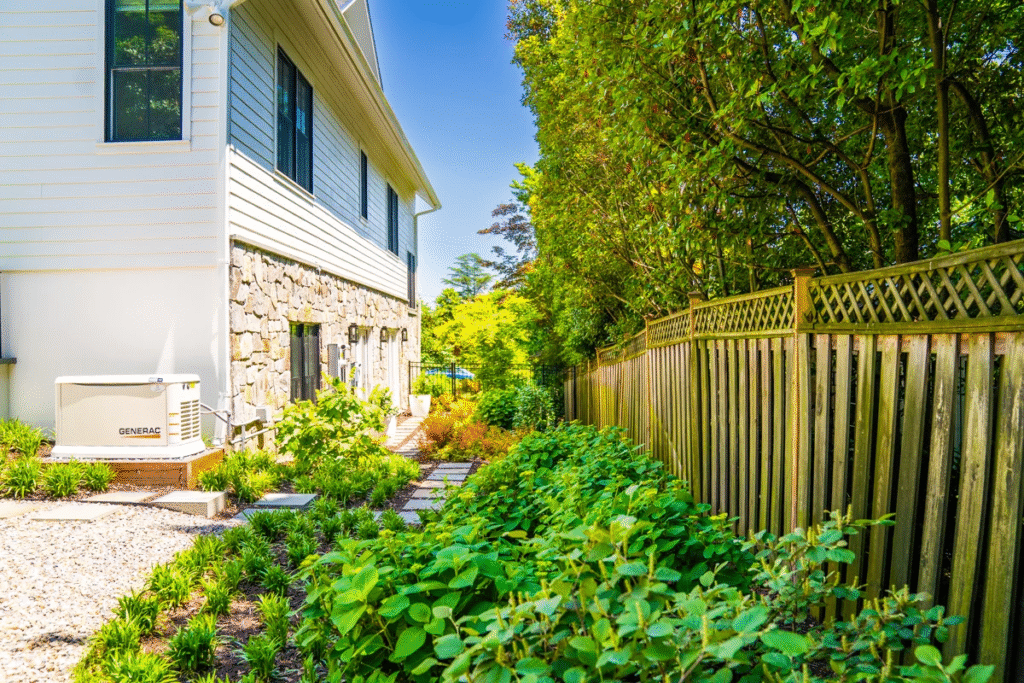
Living Wall Wonders
The ultimate decorative fence incorporates plants directly into its structure, creating a true living wall:
Integrated Pocket Panels Modern fence systems with built-in planting pockets represent the cutting edge of decorative fencing. While the initial investment exceeds traditional fencing, the dramatic effect justifies the cost for many homeowners.
“The key to successful pocket panel plantings is thorough irrigation planning,” explains irrigation specialist Marco Gutierrez. “These systems dry out quickly and require either dedicated drip lines or consistent hand-watering. But when properly maintained, they create a lush vertical tapestry unlike any other garden feature.”
Espalier Elegance Transform a simple fence into a sophisticated living structure by training fruit trees or ornamental specimens in formal patterns against it. This ancient technique creates stunning geometric designs while producing fruit in minimal space.
“Apple, pear, and quince trees work beautifully for espalier,” notes pomologist Dr. Susan Amari. “The key is establishing the basic framework in the first two years through careful pruning and training. After that, maintenance is relatively simple, and the dramatic effect enhances winter interest even when the trees are dormant.”
Climbing Plant Compositions Strategic placement of climbing plants creates dramatic decorative effects on ordinary fencing. Rather than allowing a single vine to consume your entire fence, consider creating deliberate “frames” of climbing plants with negative space between them.
Garden designer William Park suggests, “Think of your fence as a canvas where climbers create living artwork. Install sturdy trellises at intervals and train different climbers on each—perhaps clematis flanked by roses, with honeysuckle as an anchoring element. The contrast between planted areas and the fence itself creates much more visual interest than complete coverage.”
Artistic Accent Integration
Elevate ordinary fencing with artistic elements that reflect your personal style:
Decorative Panel Insertion Break up sections of standard fencing with decorative metal or wooden panels. These focal points draw the eye and create opportunities for highlighting special plants. Wrought iron scrollwork, laser-cut metal designs, or wooden lattice patterns can transform an ordinary fence into a custom garden feature.
Mirror Magic Strategically placed weather-resistant mirrors create the illusion of expanded space and bring additional light into shaded fence areas. Landscape designer Julia Winters notes, “Outdoor-rated acrylic mirrors offer the same effect as glass without the safety concerns. Place them to reflect particularly beautiful plantings or garden art—the visual doubling creates extraordinary impact.”
Architectural Salvage Incorporation Vintage doors, window frames, and architectural elements integrated into fence sections add character impossible to achieve with new materials. These conversation pieces become natural focal points for special plantings or garden art displays.
Unique Garden Fence Ideas That Set Your Space Apart
When you’re ready to move beyond conventional approaches, these innovative fence garden ideas create truly distinctive outdoor spaces.
Multifunctional Marvels
Today’s most innovative fence designs serve multiple purposes simultaneously:
Solar-Powered Illumination Integrate solar lighting directly into your fence design for dramatic evening effects that highlight special plants after dark. Options range from simple string lights to sophisticated integrated panel systems.
“The placement of fence lighting completely transforms how we experience the garden at night,” explains garden lighting specialist Elena Volkov. “Rather than harsh overhead lighting, fence-mounted fixtures create gentle lateral illumination that highlights plant textures and creates inviting garden rooms.”
Sound Integration For urban gardens, fences that incorporate sound-dampening features create more peaceful outdoor spaces. Materials like living walls, thick vine coverage, or specialized acoustic panels all reduce ambient noise while enhancing visual appeal.
Built-In Furniture Elements Forward-thinking fence designs incorporate seating, tables, or storage directly into the structure. These space-saving innovations are particularly valuable in small gardens where every square foot matters.
Urban garden specialist Marcus Reeves explains, “In city gardens under 500 square feet, built-in bench seating along fence lines can free up 15-20% more plantable space compared to freestanding furniture. The psychological effect is even greater—the garden simply feels more spacious and intentional.”
Material Innovation
Unconventional materials create fence gardens unlike any others in your neighborhood:
Gabion Structure Foundation Wire cages filled with stones create dramatic, modern fence bases that double as planting opportunities. The spaces between stones provide perfect pockets for drought-tolerant specimens like sedums, sempervivums, and small native grasses.
“Gabion structures offer remarkable design flexibility,” notes landscape architect Thomas Hughes. “You can fill sections with different materials—perhaps river stones transitioning to recycled glass or even pinecones—creating visual interest before you even add plants.”
Living Willow Structures For the truly adventurous gardener, living willow fences create dynamic boundaries that change seasonally. These structures begin as freshly cut willow rods pushed into moist soil, which then root and grow into a sculptural living fence.
Willow artist Sophia Chen explains, “The beauty of living willow fences is their evolution. In winter, the architectural branch structure creates stunning outlines. Spring brings fresh green growth, summer offers leafy shade, and fall delivers golden color. It’s a fence that truly participates in seasonal changes.”
Concrete Canvas Sculpture This innovative material—a flexible concrete-impregnated fabric that hardens when hydrated—allows the creation of sculptural fence elements impossible with traditional materials. The resulting organic forms create dramatic backgrounds for architectural plants.
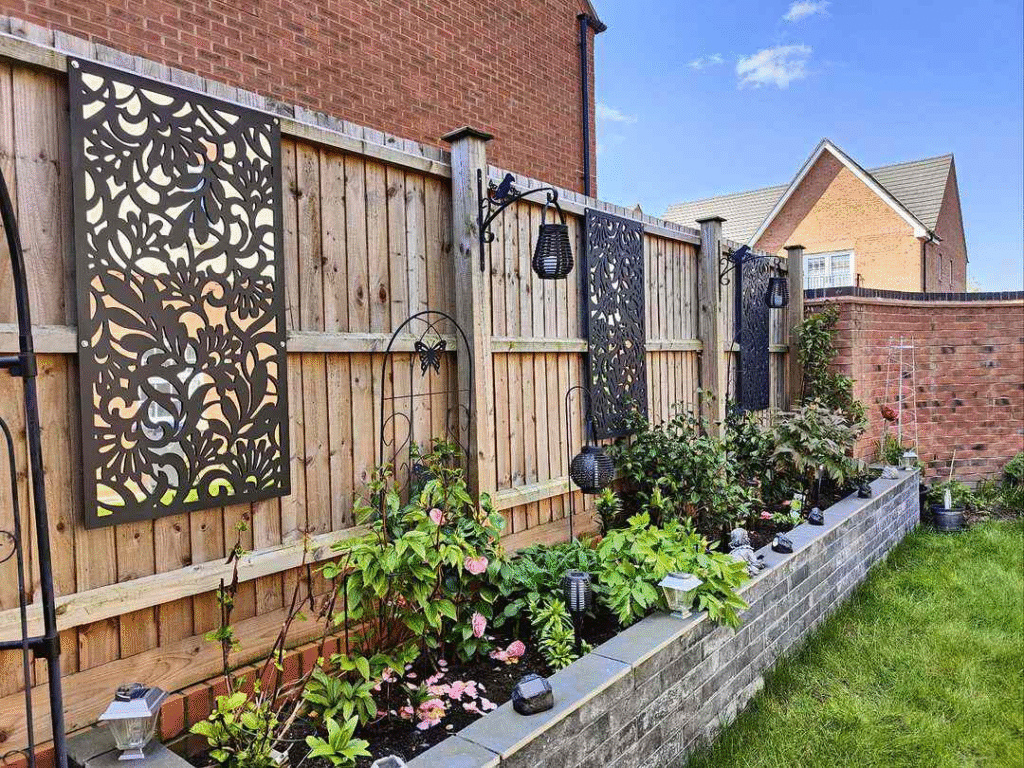
Landscaping Fencing Ideas That Unify Your Garden Design
The most successful fence gardens don’t exist in isolation—they connect seamlessly with your broader landscape design.
Strategic Plant Selection
The plants you choose can make or break your fence garden design:
Layered Perennial Borders Create depth and seasonal interest by planting in distinct layers: low ground covers at the fence base, mid-height perennials in the middle ground, and strategic vertical accents to draw the eye upward.
Plant ecologist Dr. James Chen recommends, “For the most sustainable fence plantings, mimic natural edge habitats with a progression of heights. This creates microhabitats supporting diverse beneficial insects while reducing maintenance needs. The visual effect is also more sophisticated than single-height plantings.”
Four-Season Structure Planning Thoughtful combinations of evergreens, deciduous shrubs, perennials, and annuals ensure your fence garden remains interesting year-round. Pay particular attention to winter structure when designing your planting plan.
“The most common mistake in fence plantings is neglecting winter interest,” explains garden designer Rebecca Moore. “Incorporate plants with distinctive bark, persistent seedheads, or architectural branching patterns. Ornamental grasses left standing until late winter provide texture and movement during the garden’s dormant phase.”
Color Echoing Unify your fence garden with your broader landscape by repeating key plant colors at strategic intervals. This technique creates visual coherence even when using diverse plant materials.
Fence-to-Landscape Transitions
Create natural connections between your fence and the surrounding landscape:
Curved Bed Lines Rather than straight planting beds parallel to your fence, create gentle curves that soften the boundary’s linear nature. These organic shapes integrate the fence more naturally into your overall garden design.
Transitional Height Elements Install taller plants or structures where fencing meets open garden space to create a gradual transition rather than an abrupt boundary. Ornamental trees, tall grasses, or vertical garden elements all serve this purpose effectively.
Landscape designer Maria Jackson explains, “The key to natural-looking fence integration is avoiding the ‘moat effect’—that obvious strip of different plantings along the fence line. Instead, allow elements of your main garden to approach and even touch the fence in places, creating a more organic relationship.”
Purposeful Gateways Entry points through fencing offer perfect opportunities for creating distinctive garden moments. Consider arbors, pergolas, or special plantings that mark transitions between garden areas.
Bringing Your Fence Garden Vision to Life
Creating your ideal fence garden requires thoughtful planning before the first plant goes into the ground.
Planning for Success
Assess Environmental Factors Before selecting plants for your fence garden, evaluate these critical conditions:
- Light patterns throughout the day (especially important for fences creating shade)
- Soil conditions along the fence line (which may differ from your main garden)
- Moisture availability (including rain shadow effects from the fence itself)
- Wind exposure and protection offered by the fence orientation
Create a Maintenance Strategy Even low-maintenance fence gardens require some care. Develop a realistic plan addressing:
- Irrigation access (particularly challenging for fences far from water sources)
- Pruning needs to prevent damage to the fence structure
- Seasonal clean-up requirements
- Long-term plant management as specimens mature
“The most successful fence gardens grow from realistic maintenance plans,” emphasizes horticulturist Emma Wilson. “Better to create a simple design you can maintain properly than an elaborate vision that becomes overwhelming. Start with drought-tolerant natives near difficult-to-reach fence areas, reserving higher-maintenance plants for easily accessible sections.”
Installation Tips From the Experts
Soil Preparation Priorities Many fence lines have compacted, poor-quality soil from construction activities. Take time to properly amend these areas before planting.
Soil scientist Dr. Marcus Wright recommends, “Excavate at least 12 inches deep along fence lines, incorporating quality compost and creating slight berms to improve drainage. This initial investment dramatically improves long-term plant performance.”
Irrigation Infrastructure Install drip irrigation before planting to ensure consistent moisture in these often-neglected garden areas.
“Fence plantings frequently fail due to inadequate irrigation,” notes irrigation specialist Carlos Mendez. “Drip lines with multiple emitter types accommodate different plant water needs within the same zone. Include shut-off valves for seasonal adjustments as plants establish and mature.”
Plant Establishment Schedule Develop a phased planting approach, beginning with anchor specimens and adding layers over time.
Garden coach Tara Williams advises, “Start with structural elements—climbers, shrubs, and accent plants—allowing space for later additions. This phased approach lets you observe how the initial plantings perform before completing your design. It also distributes the initial investment over multiple seasons.”
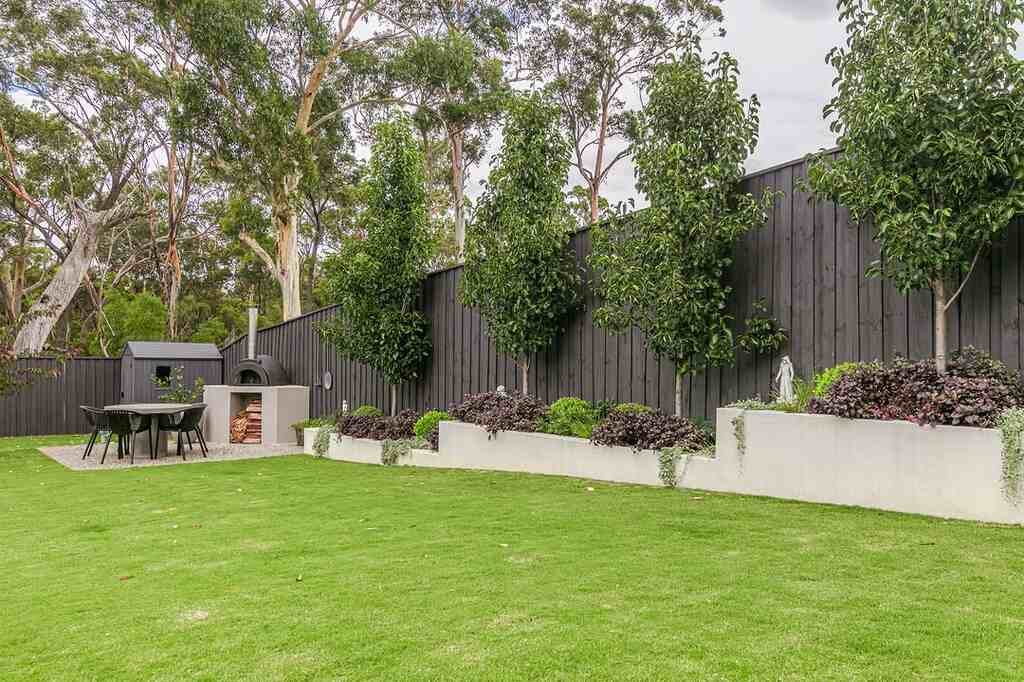
Common Fence Garden Challenges and Solutions
Even well-planned fence gardens encounter obstacles. Here are expert solutions to the most common issues:
Root Competition
Fences often align with property boundaries where neighboring trees create fierce root competition.
Solution: Install root barriers 18-24 inches deep along affected fence sections, or create raised planting beds with physical barriers beneath them. Select tough, shallow-rooted species known to tolerate root competition.
Access Limitations
Maintaining plants along fence lines can be physically challenging, especially in narrow passages.
Solution: Plant low-maintenance, drought-tolerant species in hard-to-reach areas. Create stepping stone paths for access, and use extended-reach tools for necessary maintenance.
Privacy Without Height
Zoning restrictions sometimes limit fence height below what’s needed for privacy.
Solution: Landscape architect Sophia Chen suggests, “Create the illusion of height by planting tall, narrow specimens at strategic intervals along your fence line. Specimens like Italian cypress, columnar junipers, or ornamental grasses add 3-5 feet of effective privacy screening without violating height restrictions.”
Transforming Everyday Fences Into Extraordinary Gardens
Your fence represents valuable garden real estate too often overlooked in landscape planning. By reimagining this boundary as an opportunity rather than an afterthought, you can create distinctive garden spaces that maximize your property’s potential.
Whether you choose budget-friendly approaches like repurposed materials and clever container displays, decorative techniques like living walls and artistic accents, unique innovations incorporating unconventional materials, or comprehensive landscape integration strategies, your fence garden can become a defining feature of your outdoor space.
The most successful fence gardens evolve with your needs and interests. Begin with a clear vision of your fence’s primary functions, add creative elements that express your personal style, and develop a realistic maintenance approach. Your reward will be a distinctive garden boundary that enhances your property’s beauty and functionality for years to come.
What fence garden approach appeals most to your landscape vision? The possibilities are as boundless as your imagination.
